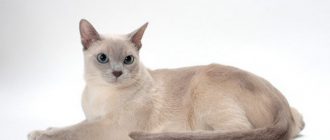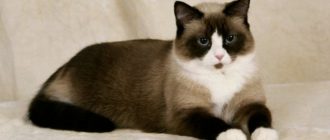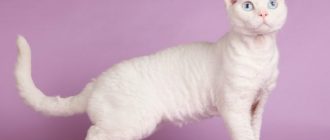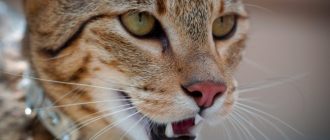Brief description of the breed
Contents
If you are an admirer of exotic animals, which this are not dangerous and do not differ in large sizes, then a bengal cat is exactly what you are looking for. Breed bred by crossing small Asian leopard cats with domestic cats. Bengal cat is a broad-shouldered shorthair pet, with a spotty or marble color. Such a pet will be the pride of any family. But beautiful looks don’t should be the only reason for buying a pet of this breed. It should be understood that a Bengal cat, like any other pet, requires attention, and therefore his time owner. Bengal cat is distinguished by tenderness and affection, while the animal does not require particularly complicated care. This pet is smart curious and very active. The animal is constantly in motion, loves to climb to heights, easily gets used to walks on it’s necessary to train a cat on a leash from an early age. Some members of the breed like to play in the water. If a if you have an aquarium, you can notice the cat’s particular interest in to your fish. These funny animals require a lot of attention. This pet is best suited for a person who has a lot free time that he can devote to a pet, play with him and take out for walks. If you are a busy person, then it’s better to buy a cat of a different breed. Bengal cats may have very diverse color, the same goes for eye color. So Thus, representatives of this breed are very diverse. Bengal cats are very different from other cats, not only in color, but also size, mainly due to its muscle mass. Especially if it’s it’s about a male Bengal breed. A unique feature of Bengal, of course, is his coat. Most people when they hear about a Bengal cat is presented as a spotted animal. In fact in fact, these cats may have a marble color. And under marble should understand the color in the form of horizontal markings, different in its shades. The color of cats of this breed may have such shades: brown (orange-brown with black spots or in marble form), cream (cream spots on a dark background or in marble colors), silver (silver metallic with black stained or in marble color). Cats with blue coat, but this color is officially deviation from the norm. As for eye color, they can be any color: from bright golden to bright green or brilliant yellow color. Also considered common blue tint of the eyes. In most cases, eye color and coat color depends on what exactly the breeder wanted to achieve.
Photo of a Bengal cat:

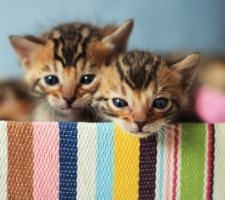
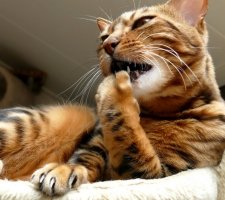
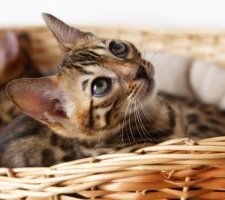
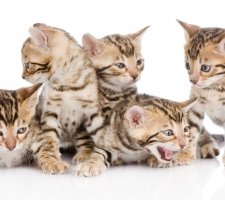
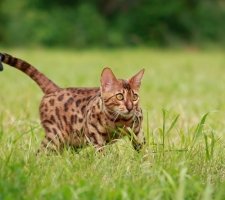

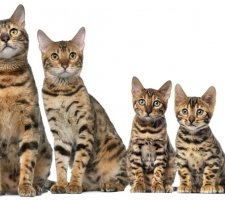
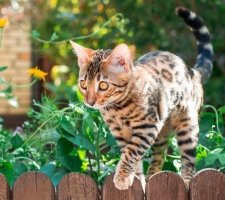 Pictures of Dog Breeds |
Pictures of Dog Breeds |
The story of a bengal cat
People have always been attracted by the beauty and independence of wild cats, more Moreover, the man even tried to domesticate such wild cats as the cheetah or lion. In order to satisfy such an interest, it was deduced the breed of cats that we call Bengal today (due to region of its origin). The breed was bred by crossing small asian leopard cats with regular domestic cats cats. Bengal domestic cat, in fact, is a hybrid wild bengal cat and other breeds. Appearance of this unusual breed occurred in 1963 in america through diligence geneticist breeder Gene Mill. She became interested in hard the fate of Bengal cats (which are also called dwarf cats and Far Eastern) during his visit to Bangkok in 1961 – there was a mass extermination of these animals because of valuable fur, so similar to leopard. Imbued with their difficult fate (thanks to enterprising merchants, cats were on the verge of extinction in Thailand), Mill acquired a Bengali the female. But not just for the sake of salvation – the breeder’s main idea was getting an individual with an original Bengali appearance and the complaisant nature of the domestic cat. The birth of a baby girl (from wild cat and domestic cat Mill) in the 63rd became a landmark year for this breed, although prior to official recognition as felinological organizations that occurred only in the 1990s were still far away. The kitten, named its owner Kin-Kin, looked like a mother – and color, and habits. By inbreeding, the breeder appeared one litter of Bengalis, a little similar in character to affectionate domestic pets. On this experimental work to develop a new The breed for a while (until the early 1980s) was interrupted. Later Gene Mill has teamed up with other American scientists, renewing the idea of creating wild pets using Bengalis from India, Egyptian Mau and Burmese cats. It revealed, that only in the fourth generation are bengal kittens finally found soft features of behavior – coping, lack of fear of a person without losing the characteristic leopard coat. In addition, only females of the first generations could bring progeny. And males up to the fourth remained barren. Domestic Bengal cats were born after a long and difficult the work of geneticists who have managed to create a friendly animal capable of find a common language not only with members of the host family, but also with any tailed brethren. Bengalis first appeared in Russia in 2005 year, at first the breed was considered very rare (kittens were brought from States and Canada) and expensive. But today in our country already many nurseries willing to sell a kitten as a home Anyone who wants it at a price of 20,000-25,000 rubles. On the web you can find, however, ads for the sale of such a breed for 5000-10000 rubles. The cost of exhibition show kittens is much more expensive, she can reach 100,000 rubles and above.
Bengal cat character
Bengals are very funny and active animals. But definitely we can say that these cats are not suitable for everyone. They are very smart curious and active, require a lot of attention. If the owner will not give the pet enough time, then this fraught with consequences, as the behavior of a cat can become crushing. If you leave a Bengal cat, for example, on all day alone, then she will start to open closets, pulling out all of them, may scratch the furniture or chew on decor items. Cats of this breed simply adore their master and his whole family. It should be noted that the need for attention sometimes plays a cruel joke with the owner. For example, if a cat, jumping on the table will see your negative reaction, for her it will mean a way to get your attention. Therefore, scolding cat, keep in mind that the animal must be aware that it is bad. Like any cat, Bengal has individual traits character. Despite this, most representatives of the breed Get along well with other pets and children. Moreover, it is better to get such a cat precisely for those families in which there are children, because they will play with the animal, and this is a favorite Bengal cat occupation. Cats of this breed will need a large vertical territory, and the higher the better. Also they love water. Do not be surprised if your pet shows a desire take a shower or bath with you. Some owners of these cats install touch water taps in the kitchen or in the bathroom. So Thus, the pet will be able to splash in the water at any time. well and if there is a fountain in the yard, then this will be a real celebration for your cat. The playful character of a Bengal cat is positive affects the training process. Pet can be taught perform various tricks, but training should take place in playful and reinforced by your favorite treats. a kitten is better at that breeder who contains kittens in the house. It will be nice to meet with the parents of the animal, so that make sure the health and cleanliness of your pet.
Maintenance and care
Bengal cats have a short but luxurious coat, behind which very easy to care for. Just comb it out once a week. so that she is healthy and beautiful. But scratching an animal possible and more often, this will significantly reduce the amount of wool and dust in The rest of the Bengal cat requires standard care. Claws are trimmed as needed, but it is advisable to do so. weekly. Ears should also be checked for every week. pollution, inflammation and infections. In case of contamination, you need treat with a special solution prescribed by the veterinarian. forget about the need for regular brushing. Pasta should use only on the recommendation of a veterinarian. All mentioned procedures must be started from an early age so that Bengal kitten got used to them faster.
Feeding
The digestive system of Bengal cats cannot be called hassle-free. Because of this, it is crucial from an early age take care of the health of the pet, choosing the right diet. There are two feeding options to choose from – a natural menu and industrial (wet and dry granular feed). Sometimes owners feed cats and homemade food from their table, but this wrong – fatty foods, spices and seasonings, smoked meats, sweets and flavoring additives bring only harm to the animal’s body. Of products that are undesirable for a cat can be distinguished plant foods that contribute to gas formation (peas, beans, corn, grapes, beets), citrus fruits, salt, bones (chicken and fish), raw river fish, fatty meat (pork, lamb), mushrooms, nuts, garlic, onions, chocolate, alcohol, flour, milk (it is advisable for adult cats to give kefir, fermented baked milk, cottage cheese with fat content not more than 5%), fat sour cream and cream. Adult cat usually eats twice a day – morning and evening (this option preferred), sometimes feeding occurs only once. Bengali baby 2-4 months old (when usually acquired kitten) eats 5-6 times, from 4 to 6 months – 4 times, from 6 to 8 months – 3 times, after which a small domestic leopard translate into adult mode. Whatever diet you choose it is unacceptable to leave food in a bowl (canned or prepared by the owner himself) after feeding the pet. The cat can eat spoiled food, and then can not be avoided eating disorders. It is permissible to leave dry food in a bowl for the whole day, but preferably, nevertheless, pour it before meals.
Natural food
The owner can independently prepare various dishes for purr in accordance with her taste preferences and characteristics of the body (allergic to certain foods, poor digestion, tendency to overeat and obesity). The big advantage of this nutrition – owner confidence in the quality and freshness of the ingredients diet. However, calculate the amount of nutrients choose the right products so that the cat’s body doesn’t experience any hypervitaminosis, nor vitamin deficiency, is quite difficult. Besides, not every busy person has time even for cooking homemade “human” food, but natural food for the cat – the same standing at the stove, washing vegetables, cooking meat, cereals and so on.
- Low-fat meat – boiled, baked or raw (previously frozen for several days), it is required daily. Adult it’s enough for the cat to grind meat into small pieces, but not bring to a puree state. Preferred veal (beef), lamb, rabbit, chicken and turkey;
- Low-fat marine fish – boiled (preferably) or raw – navaga, pollock, ice, hake. It is given to the cat no more than 1-2 times per a week. Occasionally, a cat can be pampered with a fatty fish (mackerel, Atlantic herring, saury), from which large bones;
- Offal – they should not be abused, therefore 1-2 times a a week will be enough. The cat can be given boiled and shredded liver, lung, heart;
- Cereals – (rice, buckwheat, barley, semolina) give the cat several times per week, mixing them with meat, fish or offal;
- Vegetables – they are boiled or given raw, chopped and mixed with food of animal origin. Cats can eat zucchini, pumpkin, cabbage (if there is no problem with gas formation), carrots. Also useful for cats and greens in small quantities – parsley, dill, lettuce;
- Eggs – you can give only the yolk or the whole egg in the boiled form 1-2 times a week;
- Vegetable oil – it is added to ready-made dishes (vegetables, meat, cereals, etc.);
- Low-fat fermented milk products – varenets, yogurt, kefir without dyes and flavorings;
- Germinated cereals – can be raised or acquired, the cat will happy to eat healthy weed.
Finished feed
Wet foods in iron cans or spider bags, as well as dry granular feed allows the animal to get all the necessary vitamins and minerals, they are highly digestible and have a small consumption rate. Such products are useful and significantly save. cat owner’s time, all that is required is to open the package and pour food into a bowl. The best pet food – high quality holiviki (“Orijen”, “Eagle Pack Holistic Select “,” Canidae “, etc.) and extra-premium quality products (“Eukanuba”, “Iams”, “Bosh”, etc.). The main component of their composition is natural meat, most often farm and fresh. They do not contains vegetable protein (or is contained, but in small quantities), GMOs, harmful aromatic and flavoring additives. Such feed is produced in Europe, which affects their cost. Not in every pet store you can find products for cats this level, so often you have to either order them in online stores, or wait for the appearance in special stores for animals. Unfortunately, most well-known brands of feed inferior quality – premium and economy class (sometimes the meat content does not exceed 4-5%) can only satisfy hunger, but in no way benefit the body. Eating cheap feed threatens the cat with allergies, urolithiasis, problems digestive tract. Before purchasing finished feed the owner of the cat is better to study the composition of the product. It’s better total, if the package contains a detailed list of ingredients and their percentage ratio. The focus should always be on protein. animal origin (i.e. meat, fish, poultry). If after several pet meals have loose stools or vomiting – This is an occasion to contact a veterinarian.
Health and Disease
Bengal cats are generally considered relatively healthy. pets. But nevertheless, they can distinguish a number of ailments, which are found most often. The main ones include distal neuropathy – A disorder of the nervous system that causes weakness. Such an ailment in mainly occurs in animals over the age of one year. TO fortunately, pets most often deal with such a disease by yourself. Also, in representatives of this breed it occurs called squamous syndrome in various forms (mild or heavy). Hip dysplasia is also common. She in severe cases can lead to lameness. Sometimes they diagnose and hypertrophic cardiomyopathy (one of the varieties of diseases hearts). This ailment is hereditary. By inheritance dislocation of the patella may also be transmitted. In severe cases this disease can only be managed surgically. TO Bengali vision problems cats include progressive retinal atrophy and degenerative eye diseases.

